Introduction
Soybean is the oilseed most cultivated worldwide, and the USA and Brazil are the greatest producers. Soybean currently occupies the largest planted area of legumes in the world, with Brazil producing 135.9 million of grain in 2020/2021, close to 36% of world production (Conab, 2021). Oil and bran are the main products from soy processing. Additionally, soybean oil can be used in the production of biodiesel (Shehata et al., 2015; Colombo et al., 2019).
The need for superior quality seeds is one of the obstacles to overcome in the search for higher soybean yields, especially in countries with tropical climate such as Brazil, where seeds are produced during the season of cultivation destined to obtain grains. In Brazil, seeds are produced during the spring-summer season, when the harvest usually coincides with the rainfall period (Ávila et al., 2011). This is due to the prohibition of soybean cultivation in winter to control the Asian rust (Phakopsora pachyrhizi) (Godoy et al., 2016). However, the winter season is ideal to produce higher quality seed lots, given the absence of rains during the harvest.
Seed productivity, like other agronomic characteristics such as components and yield, varies as a result of genotype selection, soil management, reduced interspecific competition between plants and the interaction of these factors (Baron et al., 2018). However, the soybean plant can adapt to its exposed arrangement, due to the morphophysiological modifications known as plant plasticity (Balbinot Junior et al., 2018; Ferreira et al., 2020). These modifications include the ability to change the main components (number of pods per plant, number of grains per pod, and seed weight) and grain yield according to the number of plants per area, thus, maintaining constant productivity over a wide range of plant densities (Board & Kahlon, 2013; De Luca & Hungría, 2014; Suhre et al., 2014; Petter et al., 2016; Souza et al., 2016).
In recent years, most of the soybean cultivars released in the market are indeterminate (modern cultivars), with less branching (Werner et al., 2016), that allow the use of lower densities without negatively impacting soybean seed yield (Corassa et al., 2018; Carciochi et al., 2019). Carpenter and Board (1997) indicate that the response of seed yield to plant density is defined by a balance between the reduced yield per plant and increased yield per unit area, due to the effect of plant addition.
Cultivars of soybean with determinate growth (e.g., NS 8590 IPRO, BRS 7780IPRO, and TMG2181 IPRO) are characterized by the completion of around 90% of vegetative growth, starting from the sprouting onset (reproductive phase) (Perini et al., 2012). The size of the vegetative growth of plants of indeterminate growth (e.g., NS6906 IPRO, NA 7337 RR, and BMX Power IPRO) increases from two to four times after the sprouting onset (Baigorri & Gassen, 2009). These materials feature a longer period of overlap of vegetative and reproductive phases, growth in height and emission of the first or the beginning of the flora in comparison with determined cultivars (Zanon et al., 2016). Plants of semi-determinate growth (e.g., NA 7337 RR, NS 6209 RR, and M 7739 IPRO), reach 70% of their final height when they sprout (Nogueira et al., 2014).
Research studies on the trend of soybean cultivars in response to the different sowing densities show contradictory results; some cases confirm the interaction between soybean genetic materials and sowing density, and others do not (Soares et al., 2015). These studies demonstrate that a plant population of300,000 plants ha-1 is the most suitable for soybean yield (Balbinot Junior et al., 2015; Enciso-Maldonado et al., 2021). However, Ribeiro et al. (2017) observed that, regardless of the soybean cultivar, a plant density of up to 600,000 plants ha-1 did not affect grain yield, plant height, lodging, harvest index or number of grains per pod. Similar results were obtained by Prusiński and Nowicki (2020), who did not observe the influence of the density and the space between lines on soybean yield.
In addition, Rahman et al. (2011) found that the yield and accumulation of protein and nutrients in soybean seeds decrease as the density of seedlings increased. Thus, there is a need for research to fill in these gaps and to generate information on the choice of suitable plant populations per area for the genetic materials of soybean currently available to farmers.
This study aimed to evaluate the agronomic characteristics (plant height, stem diameter, number of branches, number of pods per plant, number of seeds per plant, number of seeds per pod, weight of 100 seeds and seed yield) and physiological quality (germination, first count of germination, seedling length, dry mass of the shoot and root, and accelerated aging test) of soybean seeds of cultivars TMG2181 IPRO, M 7739 IPRO, and BMX Power IPRO, considering different plant populations.
Materials and methods
The experiment was carried out during the 2017/2018 agricultural harvest at the experimental facility of Agência Goiana de Assistência Técnica, Extensão Rural e Pesquisa Agropecuária (EMATER), Anápolis-GO, Brazil, at an average altitude of 1050 m a.s.l. Soil samples, classified as Red-Yellow Latosol (Embrapa, 2013), were collected at the crop location, from the 0-20 cm layer, and sent to the laboratory of the experimental facility for physico-chemical analysis (Tab. 1).
TABLE 1 Results of the physico-chemical analysis of samples (0-20 cm deep) of the soils used in the experiment.
| Attributes | Values |
|---|---|
| pH (CaCI2) | 5.3 |
| P (mg dnr3) | 14.5 |
| K (cmolcdnr3) | 0.21 |
| Ca (cmolcdnr3) | 2.3 |
| Mg (cmolcdnr3) | 0.7 |
| H + Al (cmolcdnr3) | 2.0 |
| V (%) | 60.0 |
| Organic matter (g dnr3) | 33.0 |
| Sand (g kg1) | 460.0 |
| Silt (g kg-1) | 110.0 |
| Clay (g kg1) | 430.0 |
The prevailing weather conditions at the time of the experiment are presented in Figure 1.
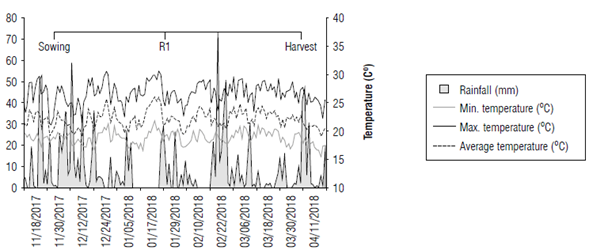
FIGURE 1 Daily climate data: precipitation (mm), maximum temperature (°C), minimum temperature (°C) and average temperature (°C) occurred during the period of the harvest from November 2017 to April 2018, in Anápolis-GO, Brazil. Data provided by the network of stations of SECTEC/ SIMEHGO (Secretary of State for Science and Technology - Goiás), Brazil.
The experiment was conducted in a completely randomized block design, 3x4 factorial arrangement, with four replicates. The treatments consisted of three soybean cultivars, TMG2181 IPRO, M 7739 IPRO, and BMX Power IPRO, at four plant densities, 9,11,14, and 16 plants m-4, corresponding to the following population densities: 180,000,220,000, 280,000 and 320,000 plants ha-4.
The cultivar TMG2181 IPRO belongs to the maturation group 8.1, has determinate growth and high demand for soil fertility. M 7739 IPRO belongs to the maturation group 7.7, has semi-determinate growth and high demand for soil fertility. BMX Power IPRO belongs to the maturation group 8.0, has indeterminate growth and high demand for soil fertility.
The experiment plots consisted of four rows of 5.0 m length, spaced at 0.50 m. The useful area of the plot included two central rows, with a suppression of 0.50 m from their edges, resulting in 4 m2 of total useful area.
The soil was prepared according to the standard practices by plowing (disk plow) and leveling grade, with the application of only regular fertilization for the seeding, using a 05-25-20 compound fertilizer, made up by nitrogen, phosphorus, and potassium (400 kg ha-4). The seeds of the three cultivars were sown manually on 12/01/2017, with the help of laces made of satin previously labeled according to the spacing between seeds. Twenty-five percent more seeds than recommended for each density tested were used. At 10 d after the emergence of seedlings, the plants were pruned to reach the desired population densities.
Manual harvest of the useful area began on 04/01/2018, when the plants reached stage R8, with 95% of the pods in brown color, which indicated ripeness. At first, 10 plants were collected in the useful area of each plot for evaluation of the following characteristics: plant height (PH) - measured in cm between the stalk of the plant and the apical edge of the main stem of the plant, using a measuring tape; stem diameter (SD) - diameter of the stalk, using a digital caliper with an accuracy of 0.01 mm, about 2 cm above the soil; number of branches per plant (NBP) - counting the average number of branches in the plant; number of pods per plant (NPP) - calculating the overall mean of pods in the plants; number of seeds per plant (NSP) - counting the seeds formed in the plants; number of seeds per pod (NSPP) - calculating the ratio between the number of seeds per plant and the number of pods per plant; weight of 100 seeds (W100S) - using random samples of 100 seeds. In addition, the seed yield (SY) was computed through an evaluation of the mass of the seeds originated from all the plants collected in the useful area of the plot, weighed using a precision scale of 0.001 g (model TP 200S, OHAUS Corporation, USA), expressed in kg ha-1 and corrected to 12% of moisture content (wet base).
With the results of the agronomic characteristics and yield established, the raw batch of seeds obtained in each plot was used to evaluate their physiological quality by performing the following analyses: germination (GER) - carried out with 4 replicates of 50 seeds for each plot and the counting of normal seedlings conducted in the eighth day after the seeding (MAPA - ACS, 2009); first count of germination (FCG) - carried out together with the germination test, by calculating the percentage of normal seedlings in the samples on the fifth day (MAPA - ACS, 2009); seedling length (SL) - using four replicates of10 seeds for each plot, measuring the total length of the normal seedlings after 8 d (primary root and hypocotyl) (Nakagawa, 1999); dry mass of the shoot and root (DMS and DMR) - in this evaluation, normal seedlings that came from the seedling length test were used, divided into hypocotyl and root system, with the average results expressed in dry mass of the root and dry mass of the hypocotyl in mg per sowing (Nakagawa, 1999); and the accelerated aging test (AA) - with 200 seeds in each plot distributed in translucent plastic boxes (gerbox) (Marcos Filho, 1999).
The obtained data were subjected to analysis of variance by the F test (P<0.05), and when significant, the averages of the qualitative treatments (cultivar) were compared by the Tukey's test (P<0.05); the regression analysis was applied for the quantitative treatments (densities). The SISVAR software system 5.6 was used for statistical analysis.
Results and discussion
Agronomic characteristics and seed yield
The experiment was carried out from November 2017 to April 2018, the rainy season in the Midwest region of Brazil (Fig. 1), with no water restriction during the entire cycle of the soybean cultivars under study. Regarding plant nutrition, fertilization was carried out in line with the soil analysis (Tab. 1). Therefore, no symptoms of nutrient deficiency or toxicity were observed in the three studied soybean cultivars.
The agronomic characteristics of soybean, such as PH, SD and NBP, were affected by both studied factors, but in an isolated manner. The key components of W100S and NSP were affected by the interaction of the factors soybean cultivars and plant population (CxP), whereas the NPP and the SY were affected only by the factor of the tested cultivars (C). NSPP, on the other hand, was not significant at 5% and 1% of probability in any studied factor.
In agreement with the results of the analysis of variance, the literature reports that the population of the plant factor (seeding density) (P) is a relevant variable in the study of plant arrangement and may be considered the main factor for the morphophysiological characteristics of plants (Suhre et al., 2014; Ferreira et al., 2016).
For PH, the determinate cultivar TMG2181 IPRO showed greater height average when compared to the other studied cultivars (Tab. 2). Most Brazilian commercial cultivars are around 50 cm to 90 cm in height (Sediyama et al., 2016), and determinate plants are higher for soybean cultivation (Sediyama, 2009). For SD, the determinate cultivar TMG 2181 IPRO showed a greater value when compared to the other cultivars, reaching 9.90 mm. SD is an important variable of research that may even characterize the genotypes as favorable or not for bedding.
TABLE 2 Average values of plant height (PH), stem diameter (SD), number of branches per plant (NBP) and number of pods per plant (NPP) for each soybean cultivar.
| Cultivars | PH | SD | NBP | NPP |
|---|---|---|---|---|
| TMG2181 IPRO | 77 a | 9.90 a | 10 a | 132 a |
| M 7739IPRO | 69 b | 7.71 b | 9 a | 90 b |
| BMXPowerIPRO | 70 b | 7.19 b | 5 b | 87 b |
| Averages | 72 | 8.27 | 8 | 103 |
Averages followed by lower-case letters In the same column show no differences among them according to the Tukey's test (P≤0.05 and 0.01).
The average data of NBP differed among the genetic materials studied, given that the determinate cultivar TMG 2181 IPRO produced more branches per plant, but without differences when compared to the semi-determinate M 7739 IPRO. Recent studies (Souza et al., 2016) support the findings of this research that determinate soybean cultivars produce a greater mean of branches per plant since cultivars TMG 2181 IPRO and M 7739 IPRO produced equally a greater number of branches per plant.
The component NPP exhibited a trend behavior similar to that described for PH and SD with the determinate cultivar showing a greater mean among the three genetic materials studied. However, NPP was not significantly affected by the spatial arrangement (at 5% and 1% of probability), although a reduced average of the number of pods produced per plant was observed as the concentration of plants increased. For PH versus different plant populations, regardless of the cultivar, taller plants were observed in arrangements with increased plant population (Fig. 2).
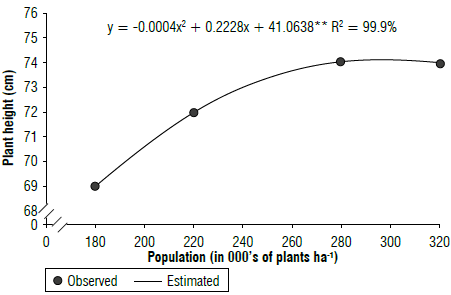
FIGURE 2 Height of soybean plants (cm) according to soybean plant populations (in thousand plants ha-1).
Increased plant population favors the growth of the apical height of the plant, regardless of the managed cultivar (Ferreira et al., 2016). Souza et al. (2016) stated that soybean cultivars BRS Valiosa RR (determinate), NA 7337 RR (semi-determinate) and BMX Potência RR (indeterminate), when exposed to populations that ranged from 245,000 to 455,000, showed average height from 91.5 cm to 94.9 cm. They reported that increased density increments the final height of the plant, due to intraspecific competition for light.
SD was affected by plant population, and a linear decrease in the average values was observed as plant population increased, with values that ranged from 8.82 mm in a population of 180,000 to 7.84 mm in a population of 320,000 plants ha-1 (data not shown). A distinct trend was observed for PH, in which the diameter values decreased in a linear manner, while plant height increased.
The average NBP in the three studied cultivars was also affected by the plant population per area, which led to the adjustment of the decreasing linear function of the data in response to the increased plant population (Fig. 3). Heiffigef al. (2006) exposed cultivar MG/BR 46 Conquista to populations ranging from 70,000 to 350,000 plants ha-1 (1.4 to 7.0 plants m-4) and found a decrease from 3.7 to 1.0 branches per plant. Souza et al. (2016) also reports a similar trend of genotypes in their research. This occurs because, in a low-density context, the availability of water, light and nutrients for each subject is higher (De Luca & Hungría, 2014).
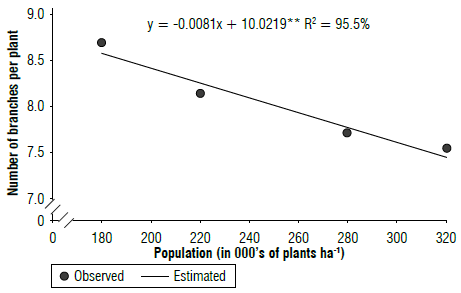
FIGURE 3 Number of branches per plant according to soybean plant populations (in thousand plants ha-1).
The phenotypic trend displayed by the genetic materials in this study was significant and a decreased number of branches per plant was easily observed according to the concentration of plants ha-1, mainly when the cultivar BMX Power IPRO was used (Fig. 4).
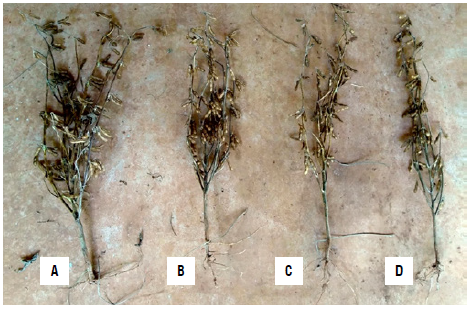
FIGURE 4 Plant structure of the indeterminate soybean cultivar BMX Power IPRO according to the populations of plants: A) 180, B) 220, C) 280 and D) 320 thousand plants ha-1.
The effect of the interaction of factors (CxP) on NSP was observed, and the variation of the average of the three cultivars in each studied population was reported. In all populations, cultivar TMG2181 IPRO always stood out from the others, and the overall mean in this category always pointed out to the same result. However, Ribeiro et al. (2017) demonstrated that the difference of this factor can be found in soybean cultivars with the same growth habit.
The average data on the NSP of the three genetic materials exposed to the different plant populations revealed the plasticity of each studied genotype, which managed to adapt to the spatial arrangements (Fig. 5). The concentration of the seeding line reduced the spacing between plants, thus decreasing NBP (Fig. 3) and, consequently, the number of seeds per plant.
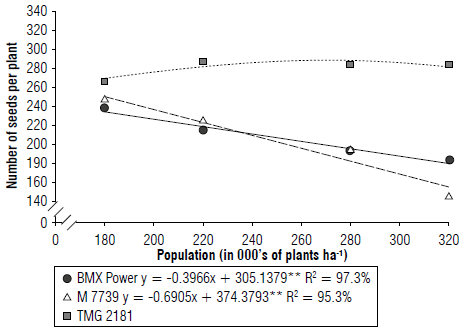
FIGURE 5 Number of seeds per plant of soybean cultivars according to plant populations (In thousand plants ha-1).
This trend is observed more frequently in plants of semi-determinate and indeterminate growth, with a linear correlation to the concentration of plants. In other words, when the quantity of plants increases (population of plants ha-1), the quantity of generated seeds decreases. The determinate cultivar TMG2181 IPRO did not show significance in this variable, which demonstrates that the plant population factor did not change its morphophysiological characteristics.
Balbinot Junior et al. (2018) report that genotypes of indeterminate habits exhibit the highest plasticity rate in response to their exposed plant population. For example, Ribeiro et al. (2017), while working with populations of 300,000 to 600,000 plants ha-1, observed a reduction from 114 to 77 grains per plant of indeterminate cultivars. The plant alters its structure in search of a better adjustment to the exposed environment and is able to increase its competition for solar radiation, nutrients, water, and soil biosphere (Ferreira et al., 2016; Petter et al., 2016).
In this study, the NSP showed a trend opposite to that of W100S. As NSP increases, the mass of the product decreases. Among the overall averages of the genetic materials researched, the determinate cultivar TMG2181 IPRO obtained greater average of branches, pods (Tab. 2) and seeds per plant, when compared to the other studied genotypes. However, it obtained the lowest W100S by a large difference. Gulluoglu et al. (2017), while working with two soybean cultivars, verified that the plants that produced greater quantities of seeds were the same in which the weights of seeds were lower.
The indeterminate cultivar BMX Power IPRO showed an increase in W100S in plant populations of 280,000 plants ha-1 (Fig. 6), followed by the decrease observed in larger studied populations. Seed weight is relevant for its ability to generate more vigorous seedlings during the germination process. This is explained in the physiological quality of seeds section.
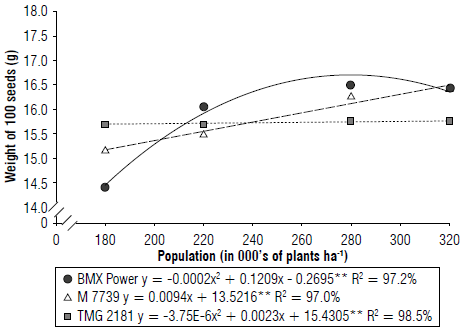
FIGURE 6 Weight of 100 seeds of soybean cultivars according to plant populations (in thousand plants ha-1).
These findings are partly consistent with those obtained by Suhre et al. (2014), who determined that the increased density of plants in the line promotes a linear increase of W100S, especially in new cultivars, or as characterized by Balbinot Junior et al. (2018), in modern cultivars (indeterminate). The component W100S is dependent on the genealogy of the material, which justifies the detection of only the effect of the cultivar factor.
Ferreira et al. (2016) and Ferreira et al. (2020) verified an increased percentage of grains per plant in lower seeding densities and, consequently, a reduced mass of these grains. These findings are consistent with those of Bellaloui et al. (2015), who demonstrated decreased levels of protein, sucrose, glucose, raffinose, boron and phosphorus in grains with decreases in seeding density. Petter et al. (2016) report that the changes in the weight of seeds are due to the harnessing of photosynthetic radiation.
Seed yield was greatly affected by just the soybean cultivar factor (C) (Tab. 3). These findings are similar to those from the literature, such as Heiffig et al. (2006), who used five populations of plants (70, 140, 210, 280 and 350 thousand plants ha-1) and observed no effect of this factor on the final production of seeds of the cultivar MG/BR 46 Conquista. The lack of an increase response in soybean seed yield with plant population can be usually attributed to the plasticity of plants, thus, corroborating the reports by Balbinot Junior et al. (2018) and Ferreira et al. (2020).
TABLE 3 Average values of seed yield according to the soybean cultivars.
| Cultivars | Seed yield (kg ha-1) |
|---|---|
| TMG2181 IPRO | 3316.15 c |
| M 7739IPRO | 4573.04 b |
| BMX Power IPRO | 5351.03 a |
| Averages | 4413.40 |
Averages followed by the same lower-case letters in the same column have no difference among them according to the Tukey's test (P≤0.05 and 0.01).
The three cultivars are characterized as highly producing cultivars based on the final yield, with the indeterminate cultivar BMX Power IPRO standing out from the other two with the highest average (89 bags ha-1), followed by the semi-determinate M 7739 IPRO (76 bags ha-1) and the determinate TMG2181 IPRO (55 bags ha-1).
While working with the three soybean cultivars and three plant populations under the conditions of the Midwest region of Brazil, more specifically in Anápolis-GO, Souza et al. (2016) also obtained significance (P≤0.05) only for the soybean cultivar factor of different growth habits, given that the indeterminate and semi-determinate cultivars demonstrated greater production average than the determinate, with averages of4,441.95 kg ha-1 (74 bags ha-1), 4,529.54 kg ha-1 (75 bags ha-1) and 4,111.76 kg ha-1 (68 bags ha-1), respectively. These yield values are close to those obtained in this research.
Additionally, the yield levels obtained for the three soybean cultivars studied are considered high worldwide. Moreover, Brazilian soybeans have a lower production cost, compared to North American soybeans, especially in relation to fertilization with nitrogen, which is made via biological N fixation. Also, the adaptation of genetic materials to cultivation under low latitude conditions, especially in the Midwest region of Brazil, associated with the adoption of more efficient management techniques including the definition of an adequate population of plants per area, contributes to lower production costs.
Physiological quality of seeds
The GER and vigor analyses of soybean seeds originated from distinct genetic materials, at different plant populations, were also carried out. The findings demonstrated influence of the soybean cultivars factor (C) only. Only the result of the vigor analysis of the DMR did not show significant differences in the physiological quality of the seed, according to the treatments applied.
Vazquez et al. (2008) used two soybean cultivars (BRSMG 68 Vencedora and M-SOY 8001) and found no link between the physiological quality of seeds and the different plant populations (400, 340, 280, 220, and 160 thousand plants ha-1) either. Ferreira et al. (2017) also reached the same conclusions. Thus, the results obtained indicate that the increased plant population does not guarantee an improved quality standard of the soybean seeds produced.
The indeterminate cultivar BMX Power IPRO produced seeds with a higher percentage of normal seedlings (93%), followed by the semi-determinate M 7739 IPRO (81°%) and the determinate TMG 2181 IPRO (80%) (Tab. 4). These differences between seed lots produced can be attributed to the occurrence of different genotypes among the studied cultivars. These percentages of germination verified by the three studied soybean genetic materials are superior to those required for the trading of soybean seeds in Brazil, above 80-85% (MAPA - ACS, 2009).
TABLE 4 Average values of germination (GER), first count of germination (FCG), seedling length (SL), dry mass of the shoot (DMS) and accelerated aging test results (AA) of soybean cultivars.

Averages followed by the same lower-case letters in the same column have no difference among them according to the Tukey's test (P≤0.05 and 0.01).
The seed vigor data (Tab. 4) showed that the average obtained had a similar trend to that described in the germination test, in which the indeterminate cultivar BMX Power IPRO stood out from the others in all the evaluations. Then, it can be concluded that this cultivar has the potential to produce seeds with a homogenous and faster germination, with more vigorous seedlings.
The vigor of seedlings was inferior to the FCG, due to the initial stressful condition, with high temperature and relative humidity. However, these results are consistent with the methodology applied in the aforementioned analysis.
The use of seeds of high quality is justified because it helps to adjust the expected population of plants, which is affected by the conditions of the soil and weather, especially in less favorable situations; this did not occur in this study. It is noteworthy that plants originating from seeds with high vigor can produce up to 35% higher grain yield (Cantarelli et al., 2015). That is why it is important to use top quality soybean seed lots. Finally, the use of an adequate plant population per area or even smaller populations generally provides better quality soybean seeds, mainly because it provides unfavorable conditions for the emergence of pathogens.
Conclusions
The phenotypic characteristics plant height, number of branches per plant, number of seeds per plant, weight of 100 seeds and grain yield of cultivars TMG2181 IPRO, M 7739 IPRO and BMX Power IPRO were altered according to the population of plants applied. The indeterminate cultivar BMX Power IPRO showed higher yield, vigor, and seed germination percentage. The different populations of plants do not influence seed quality.














